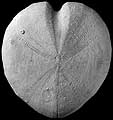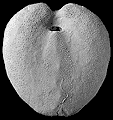The Echinoid Directory
Cardiaster Forbes, 1850, p. 422
| Diagnostic Features |
|
|---|---|
| Distribution | Upper Cretaceous (Turonian to Maastrichtian). |
| Name gender | masculine |
| Type | Spatangus cordiformis Woodward, 1853, p. 50 [=Spatangus granulosus Goldfuss, 1826, p. 148], by original designation. |
| Species Included |
|
| Classification and/or Status |
|
| Remarks |
|




